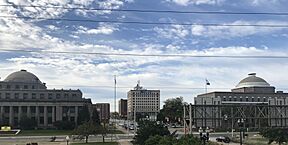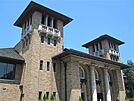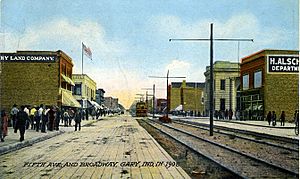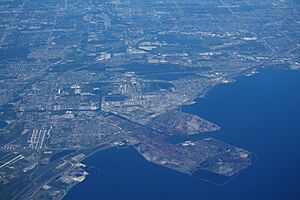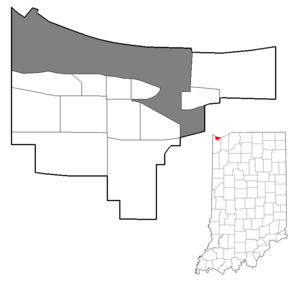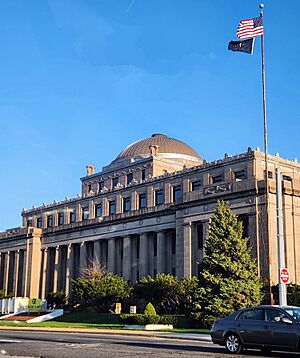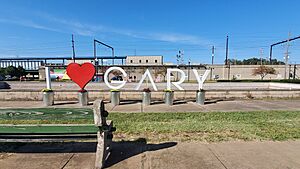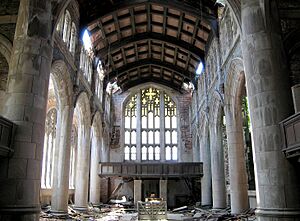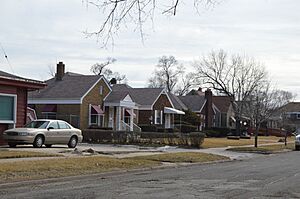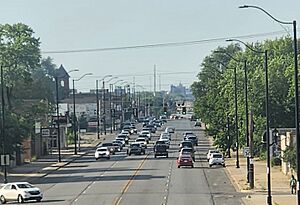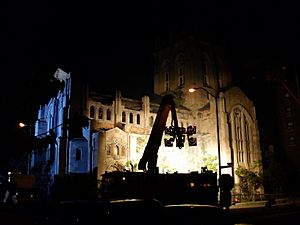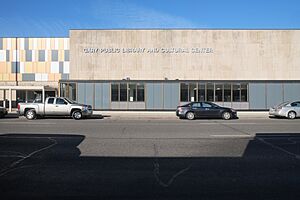Gary, Indiana facts for kids
Quick facts for kids
Gary, Indiana
|
|||
|---|---|---|---|
|
|
|||
|
|||
| Nickname(s):
City of the Century, Magic City, Steel City
|
|||
| Motto(s):
"We Are Doing Great Things"
|
|||
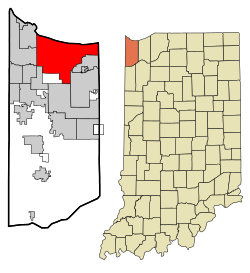
Location in Lake County and the state of Indiana
|
|||
| Country | United States | ||
| State | Indiana | ||
| County | Lake | ||
| Townships | Calumet, Hobart | ||
| Established | 1906 | ||
| Incorporated | July 14, 1906 | ||
| Named for | Elbert Henry Gary | ||
| Government | |||
| • Type | Strong mayor–council | ||
| • Body | City council | ||
| Area | |||
| • Total | 50.663 sq mi (131.217 km2) | ||
| • Land | 49.932 sq mi (129.323 km2) | ||
| • Water | 0.731 sq mi (18.938 km2) | ||
| Elevation | 597 ft (182 m) | ||
| Population
(2020)
|
|||
| • Total | 69,093 | ||
| • Estimate
(2023)
|
67,652 | ||
| • Rank | US: 566th IN: 11th |
||
| • Density | 1,385.55/sq mi (534.97/km2) | ||
| Time zone | UTC−6 (Central (CST)) | ||
| • Summer (DST) | UTC−5 (CDT) | ||
| ZIP Codes |
46401–46411
|
||
| Area code(s) | 219 | ||
| FIPS code | 18-27000 | ||
| GNIS feature ID | 2394863 | ||
Gary (/ˈɡæri/ GARE-ee) is a city in Lake County, Indiana, United States. It is located on the southern shore of Lake Michigan. Gary is about 25 miles (40 km) southeast of downtown Chicago. The city is known for its large steel industry. It is also the western entrance to the Indiana Dunes National Park.
Gary was named after Elbert Henry Gary, who helped start the United States Steel Corporation. This company created Gary in 1906 as a company town for its steel mills. Like many industrial cities, Gary's steel industry has faced challenges since the 1970s. This led to fewer jobs and a big drop in the city's population.
Gary has a rich history, especially for African Americans. It was one of the first cities in the Midwest to fully integrate its public schools in 1945. Gary also elected the nation's first Black mayor, Richard G. Hatcher. The city hosted the first and largest National Black Political Convention. Gary is also famous as the birthplace of the Jackson family, including the legendary singer Michael Jackson.
The city has its own airport, the Gary/Chicago International Airport. Public transportation includes the Gary Public Transportation Corporation and the South Shore Line railway. Gary is also home to a professional baseball team, the Gary SouthShore RailCats.
Contents
History of Gary, Indiana
How Gary Was Founded
Gary, Indiana, was started in 1906 by the U.S. Steel company. They built the city to be home to their new steel plant, Gary Works. The city was named after Elbert Henry Gary, who was the first chairman of U.S. Steel.
The steel industry created many jobs, helping Gary grow quickly. People from different countries and parts of the U.S. moved there. By 1930, Gary was Indiana's fifth-largest city. Many people came from Eastern Europe. African Americans also moved to Gary from the South during the Great Migration.
Changes After World War II
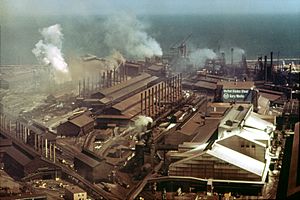
Gary's success was closely tied to the steel industry. When the steel industry faced challenges, Gary also began to decline. Many workers at U.S. Steel's Gary Works lost their jobs. For example, in 1970, over 30,000 people worked there. By 1990, that number dropped to just 6,000.
The city tried to boost its economy with new projects. However, these efforts did not stop the decline. Gary faced challenges common to many industrial cities.
Important Social Changes
Gary saw big changes in its population during the late 1900s. More Black and Hispanic people moved into the city. This led to important political changes. In 1968, Gary elected Richard G. Hatcher, one of the nation's first African-American mayors. The city also hosted the important 1972 National Black Political Convention.
By the early 2000s, Gary had a very high percentage of African-American residents. Today, Gary continues to work on improving its economy and infrastructure. In 2021, a new Hard Rock Casino opened in the city. It features items from local legends like the Jackson 5.
Geography of Gary
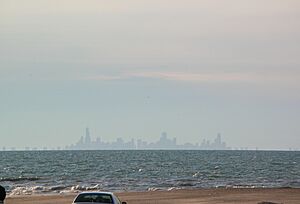
Gary is located at the southern end of Lake Michigan. The city's soil is mostly sand, almost a foot below the surface. This sand has been mined for over a century, especially for making glass.
The city covers about 50.66 square miles (131.2 square kilometers). Most of this area is land. Gary is shaped like a "T," with its northern border on Lake Michigan.
Gary is close to Chicago, about 30 miles (48 km) away. The city includes part of the Indiana Dunes National Park. This park offers beautiful natural areas like Miller Woods.
Gary's Climate
Gary has a humid continental climate. Summers are warm and humid. High temperatures average around 84°F (29°C) in July and August. Winters are cold and snowy. High temperatures average around 29°F (-2°C) in January and February.
The weather is affected by Lake Michigan. The city gets about 40 inches (100 cm) of rain each year. Winters often bring snow, averaging about 25 inches (64 cm) annually. Sometimes, "lake effect snow" can cause very heavy snowfall. This happens when moisture from the lake turns into snow over the land.
| Climate data for Gary, Indiana | |||||||||||||
|---|---|---|---|---|---|---|---|---|---|---|---|---|---|
| Month | Jan | Feb | Mar | Apr | May | Jun | Jul | Aug | Sep | Oct | Nov | Dec | Year |
| Record high °F (°C) | 70 (21) |
70 (21) |
81 (27) |
92 (33) |
100 (38) |
106 (41) |
104 (40) |
102 (39) |
103 (39) |
92 (33) |
84 (29) |
67 (19) |
106 (41) |
| Mean daily maximum °F (°C) | 31.5 (−0.3) |
35.2 (1.8) |
44.7 (7.1) |
58.4 (14.7) |
69.1 (20.6) |
79.6 (26.4) |
83.8 (28.8) |
82.5 (28.1) |
75.5 (24.2) |
64.6 (18.1) |
48.5 (9.2) |
35.8 (2.1) |
59.1 (15.1) |
| Mean daily minimum °F (°C) | 16.5 (−8.6) |
19.9 (−6.7) |
29.0 (−1.7) |
40.0 (4.4) |
49.7 (9.8) |
59.9 (15.5) |
64.9 (18.3) |
63.9 (17.7) |
56.0 (13.3) |
45.7 (7.6) |
33.2 (0.7) |
21.9 (−5.6) |
41.7 (5.4) |
| Record low °F (°C) | −22 (−30) |
−10 (−23) |
−6 (−21) |
17 (−8) |
25 (−4) |
36 (2) |
46 (8) |
43 (6) |
33 (1) |
20 (−7) |
−1 (−18) |
−17 (−27) |
−22 (−30) |
| Average precipitation inches (mm) | 1.8 (46) |
1.7 (43) |
3.3 (84) |
3.7 (94) |
3.8 (97) |
4.5 (110) |
3.5 (89) |
3.4 (86) |
3.9 (99) |
2.6 (66) |
2.5 (64) |
3.0 (76) |
37.8 (960) |
| Average snowfall inches (cm) | 7.8 (20) |
5.4 (14) |
3.0 (7.6) |
0.7 (1.8) |
0 (0) |
0 (0) |
0 (0) |
0 (0) |
0 (0) |
0.2 (0.51) |
1.7 (4.3) |
5.9 (15) |
24.7 (63) |
| Average precipitation days (≥ 0.01 in) | 9 | 9 | 11 | 12 | 12 | 10 | 9 | 8 | 9 | 8 | 10 | 9 | 116 |
| Source: Weatherbase | |||||||||||||
Gary's Neighborhoods
Gary has several unique neighborhoods.
Downtown Gary
Downtown Gary is split by Broadway, the main street. The East Side had older wooden houses. The West Side, built later, had brick homes and taller buildings. Many important businesses and buildings were on Broadway. These included department stores and movie theaters.
The West Side was home to U.S. Steel executives. It had larger homes and elegant apartment buildings. Some working-class areas had "Mill Houses" made of concrete. These were built for steel mill workers.
Downtown Gary has impressive architecture. Some old buildings have been taken down due to high repair costs. The decline of industry affected the downtown area.
Many historic buildings in downtown Gary are now abandoned. These include Union Station and the Palace Theater.
West Side Neighborhoods
- Ambridge Mann: This neighborhood is on the west side, near the steel plant. It has many unique prairie-style and art deco homes.
- Brunswick: Located on the far west side, south of Interstate 90. It includes a shopping center.
- Downtown West: This area has important city buildings. These include the Genesis Convention Center and the main library. The Adam Benjamin Metro Center is a hub for public transportation.
- Tolleston: One of Gary's oldest neighborhoods. It was founded in 1857 when railroads were built here.
South Side Neighborhoods
- Black Oak: Located on the far southwest side. It was added to Gary in the 1970s. It is the only neighborhood in Gary that is mostly white.
- Glen Park: On Gary's far south side, with homes from the mid-1900s. It has a golf course and the campus of Indiana University Northwest.
- Midtown: South of Downtown Gary. This area historically became a "black" neighborhood. Many African Americans moved here for jobs during the Great Migration.
North and East Side Neighborhoods
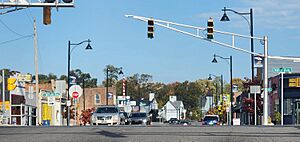
- Aetna: On Gary's far east side. It was a company town founded in 1881 by an explosives company. Gary annexed Aetna in 1928.
- Emerson: In north-central Gary, east of Broadway. Gary City Hall is located here. The U.S. Steel Yard baseball stadium was built here in 2002.
- Miller Beach: Also called Miller, it's on Gary's far northeast side. It was settled in the 1850s. Miller Beach is known for its diverse community. Many homes are close to Marquette Park and Lake Michigan.
Population Changes in Gary
| Historical population | |||
|---|---|---|---|
| Census | Pop. | %± | |
| 1910 | 16,802 | — | |
| 1920 | 55,378 | 229.6% | |
| 1930 | 100,666 | 81.8% | |
| 1940 | 111,719 | 11.0% | |
| 1950 | 133,911 | 19.9% | |
| 1960 | 178,320 | 33.2% | |
| 1970 | 175,415 | −1.6% | |
| 1980 | 151,968 | −13.4% | |
| 1990 | 116,646 | −23.2% | |
| 2000 | 102,746 | −11.9% | |
| 2010 | 80,294 | −21.9% | |
| 2020 | 69,093 | −13.9% | |
| 2023 (est.) | 67,652 | −15.7% | |
| U.S. Decennial Census 2020 Census |
|||
Gary's population has changed a lot. It has dropped by almost two-thirds since its highest point in 1960. This is mainly because of job losses in the steel industry.
Gary's Population in 2020
| Race / Ethnicity (NH = Non-Hispanic) | Pop 2000 | Pop 2010 | Pop 2020 | % 2000 | % 2010 | 2020 |
|---|---|---|---|---|---|---|
| White alone (NH) | 10,338 | 7,151 | 6,374 | 10.06% | 8.91% | 9.23% |
| Black or African American alone (NH) | 85,704 | 67,363 | 54,660 | 83.41% | 83.90% | 79.11% |
| Native American or Alaska Native alone (NH) | 162 | 197 | 112 | 0.16% | 0.25% | 0.16% |
| Asian alone (NH) | 123 | 156 | 124 | 0.12% | 0.19% | 0.18% |
| Pacific Islander alone (NH) | 15 | 5 | 11 | 0.01% | 0.01% | 0.02% |
| Other race alone (NH) | 124 | 69 | 390 | 0.12% | 0.09% | 0.56% |
| Mixed race or Multiracial (NH) | 1,215 | 1,225 | 2,201 | 1.18% | 1.53% | 3.19% |
| Hispanic or Latino (any race) | 5,065 | 4,128 | 5,221 | 4.93% | 5.14% | 7.56% |
| Total | 102,746 | 80,294 | 69,093 | 100.00% | 100.00% | 100.00% |
In 2020, Gary had 69,093 people living there. About 80.2% of residents were African American. About 10.6% were White. Hispanic or Latino people made up 7.6% of the population.
About 27.6% of residents were under 18 years old. About 18.5% were 65 or older.
Arts and Culture in Gary
Gary in Movies and Music
Gary has been featured in many creative works. The 1957 musical The Music Man has a song called "Gary, Indiana". The main character, Professor Harold Hill, pretends Gary is his hometown. Fun fact: the city wasn't even founded until 1906, after his supposed graduation year!
Many movies have been filmed in Gary. The 1996 film Original Gangstas was shot there. Scenes for the 2010 remake of A Nightmare on Elm Street were also filmed in Gary. Parts of Transformers: Dark of the Moon were filmed in the city too.
The History Channel documentary Life After People explored abandoned areas in Gary. This showed how the city changed after job losses.
Historic Places to Visit
Many places in Gary are listed on the National Register of Historic Places. These are important buildings and areas that tell the city's story. Some examples include:
- Ralph Waldo Emerson School
- Gary Bathing Beach Aquatorium
- Gary Land Company Building
- Gary Public Schools Memorial Auditorium
- Knights of Columbus Building
- Miller Town Hall
- Theodore Roosevelt High School
- St. Augustine's Episcopal Church
Public Libraries in Gary
The Gary Public Library System has a main library and several branches. The main library closed in 2011 but now houses a museum. The Lake County Public Library also has a branch in Gary.
Sports in Gary
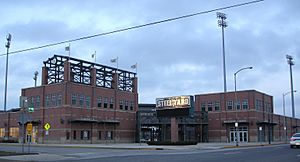
Gary is home to a professional baseball team:
- The Gary SouthShore RailCats: This team plays in the U.S. Steel Yard baseball stadium. They have won league championships in 2005, 2007, and 2013.
Gary has also hosted professional basketball teams in the past.
Education in Gary
Gary has several school districts and charter schools.
- Most schools are part of the Gary Community School Corporation.
- The Lake Ridge Schools Corporation serves the Black Oak neighborhood.
- Some areas are in the River Forest Community School Corporation.
Charter Schools
Charter schools in Gary include Thea Bowman Leadership Academy and Gary Lighthouse Charter School. These schools are managed by local boards and management companies.
Colleges and Universities
Gary is home to two state college campuses:
- Indiana University Northwest
- Ivy Tech Community College Northwest
Media in Gary
Newspapers
Gary is served by local and regional newspapers.
- The Post-Tribune is based nearby in Merrillville.
- The Times is based in Munster.
- The Gary Crusader and The INFO Newspaper focus on African-American interests.
- Major Chicago newspapers, like the Chicago Tribune, are also available.
Television and Radio
Gary has its own TV and radio stations.
- WPWR-TV (Channel 50) is a Chicago TV affiliate licensed to Gary.
- WYIN (Channel 56) is a PBS affiliate licensed to Gary.
- WGVE (FM 88.7) is a radio station owned by the Gary Community School Corporation. Students use it for learning.
- WLTH (AM 1370) and WWCA (AM 1270) are local radio stations.
Transportation in Gary
- Gary Public Transportation Corporation (GPTC): This system offers bus service throughout Gary and nearby areas. It also connects to Chicago transit.
- Gary/Chicago International Airport: This airport serves as a "third airport" for the Chicago region. It has expanded and is working to attract more airlines.
- Major highways run through Gary. These include I-90 (Indiana Toll Road), I-80, I-94, and I-65.
- Northern Indiana Commuter Transportation District (NICTD): This operates the South Shore Line. It's a commuter train that connects Chicago and South Bend.
Famous People from Gary
The Jacksons
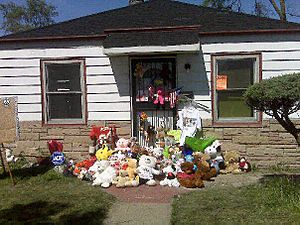
Gary is the hometown of the famous Jackson family. This family of musicians changed modern popular music. In 1950, Joseph and Katherine Jackson moved to their home at 2300 Jackson Street. Their children later recorded a song called "2300 Jackson Street".
The Jackson children who became famous entertainers include:
Other Notable People
Many other well-known people are from Gary:
- Frank Borman, astronaut on Apollo 8
- Avery Brooks, actor and director
- Polly Draper, actress from Thirtysomething
- Dianne Durham, first Black national gymnastics champion
- Karen Freeman-Wilson, first woman mayor of Gary (2012–19)
- Freddie Gibbs, rapper
- Tom Harmon, famous football player and sportscaster
- Richard G. Hatcher, mayor of Gary (1968–87)
- LaTroy Hawkins, MLB baseball pitcher for 21 years
- Alex Karras, NFL player and actor (Blazing Saddles, Webster)
- Ron Kittle, Chicago White Sox outfielder
- Karl Malden, Academy Award-winning actor
- William Marshall, stage and film actor
- Lloyd McClendon, professional baseball player and manager
- Ralph McQuarrie, conceptual designer for Star Wars
- Eddie Melton, current mayor of Gary (2024–present)
- Dan Plesac, MLB pitcher and TV analyst
- Jesse Powell, recording artist
- Jimmy Reed, blues musician
- Glenn Robinson, NBA player
- Paul Samuelson, Nobel Prize-winning economist
- Joseph Stiglitz, Nobel Prize-winning economist
- Hank Stram, NFL head coach
- George Taliaferro, first Black NFL player
- Deniece Williams, Grammy Award-winning R&B artist
- Fred Williamson, NFL player and actor
- Tony Zale, middleweight boxing champion
Sister Cities
Gary has sister cities around the world:
See also
 In Spanish: Gary (Indiana) para niños
In Spanish: Gary (Indiana) para niños


